|
CHAPTER VII.
HOW A BOY BROUGHT THE ADMIRAL TO GRIEF.
The True Story of Christopher Columbus, Called the Great Admiral | ||
7.
CHAPTER VII.
HOW A BOY BROUGHT THE ADMIRAL TO GRIEF.
COLUMBUS kept sailing on from one island to another. Each new island he found would, he hoped, bring him nearer to Cathay and to the marble temples and golden palaces and splendid cities he was looking for.
But the temples and palaces and cities did not appear. When the
Admiral came to the coast of Cuba he said: This, I know, is the mainland
of Asia. So he sent off Louis, the interpreter, with a letter to the
"great Emperor of Cathay." Louis was gone several days; but he found no
emperor, no palace, no city, no gold, no jewels, no spices, no
Cathay—only frail houses of bark and reeds, fields of corn and grain,
with simple people who could tell him nothing about Cathay or Cipango or
the Indies.
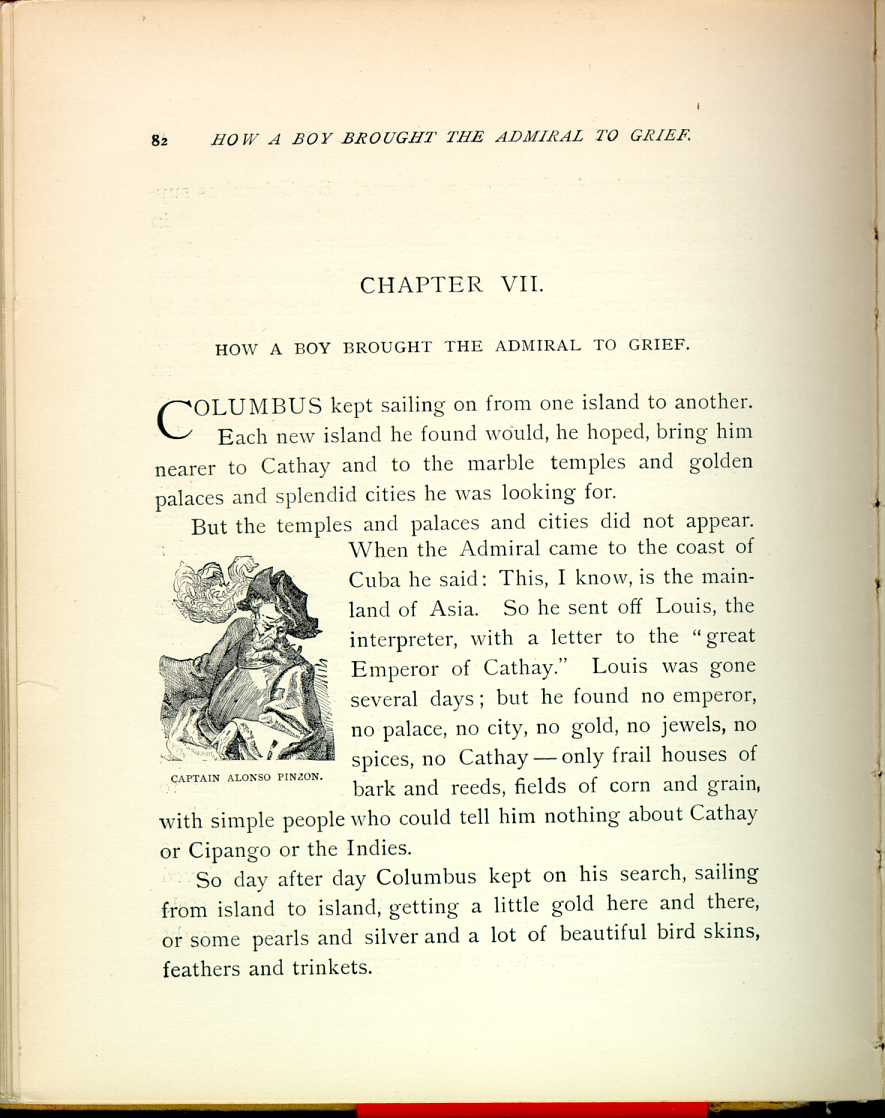
CAPTAIN ALONSO PINZON.
[Description:
Drawing of Captain Alonso Pinzon.
]
So day after day Columbus kept on his search, sailing from island to island, getting a little gold here and there, or some pearls and silver and a lot of beautiful bird skins, feathers and trinkets.
Then Captain Alonso Pinzon, who was sailing in the Pinta, believed he could do better than follow the Admiral's lead. I know, he said, if I could go off on my own hook I could find plenty of gold and pearls, and perhaps I could find Cathay. So one day he sailed away and Columbus did not know what had become of him.
At last Columbus, sailing on and troubled at the way Captain Alonso Pinzon had acted, came one day to the island of Hayti. If Cuba was Cathay (or China), Hayti, he felt sure, must be Cipango (or Japan). So he decided to sail into one of its harbors to spend Christmas Day. But just before Christmas morning dawned, the helmsman of the Santa Maria, thinking that everything was safe, gave the tiller into the hands of a boy—perhaps it was little Pedro the cabin boy—and went to sleep. The rest of the crew also were asleep. And the boy who, I suppose, felt quite big to think that he was really steering the Admiral's flagship, was a little too smart; for, before he knew it, he had driven the Santa Maria plump upon a hidden reef. And there she was wrecked. They worked hard to get her off but it was no use. She keeled over on her side, her seams opened, the water leaked in, the waves broke over her, the masts fell out and the Santa Maria had made her last voyage.
Then Columbus was in distress. The Pinta had deserted him, the Santa Maria was a wreck, the Nina was not nearly large enough to carry all his men back to Spain. And to Spain he must return at once. What should he do?
Columbus was quick at getting out of a fix. So in this case he
speedily decided what to do. He set his men at work tearing the wreck of
the Santa Maria to pieces. Out of her timbers and woodwork,
helped out with trees from the woods and a few stones from the shore, he
made quite a fort. It had a ditch and a watch-tower and a drawbridge.
It proudly floated the flag of Spain. It was the first European fort in
the new world. On its ramparts Columbus mounted the cannons he had saved
from the wreck and named the fort La Navidad—that is, Fort
Nativity, because it was made out of the ship that was wrecked on
Christmas Day—the day of Christ's nativity, his birthday.
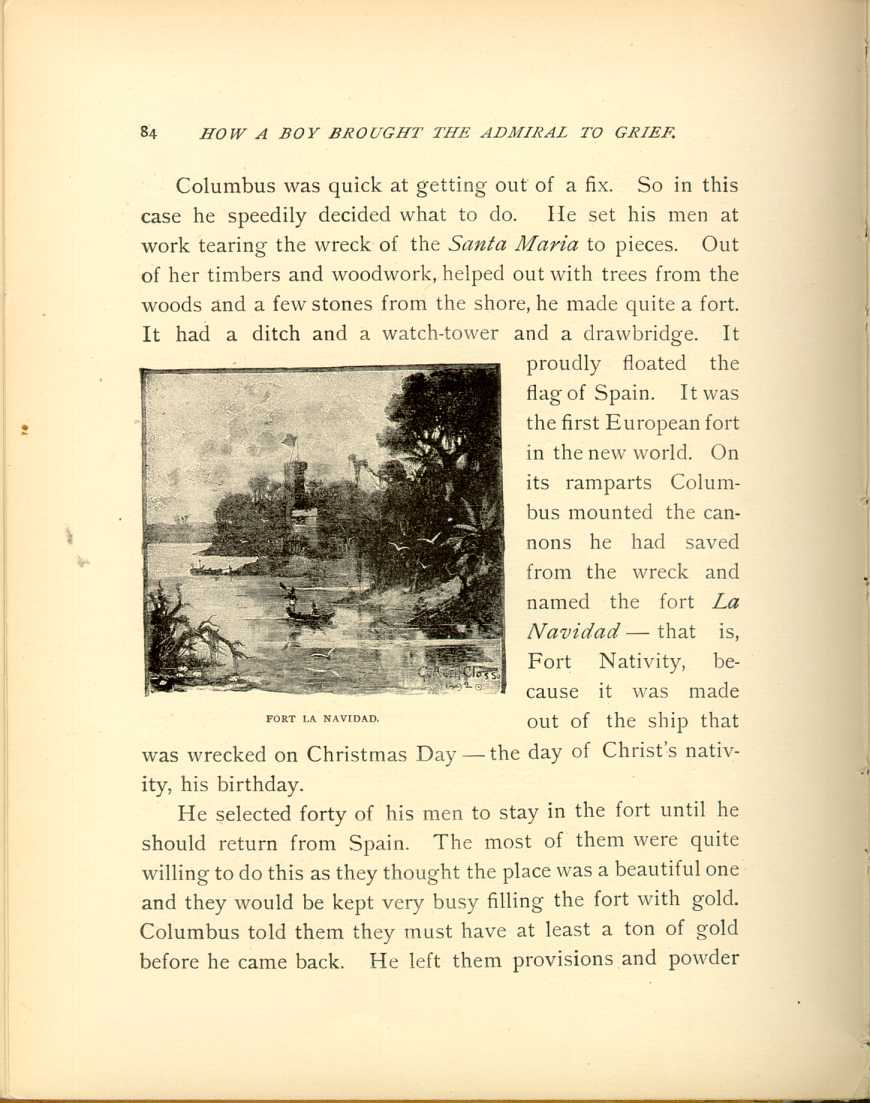
FORT LA NAVIDAD.
[Description:
Drawing of Fort Nativity.
]
He selected forty of his men to stay in the fort until he should return from Spain. The most of them were quite willing to do this as they thought the place was a beautiful one and they would be kept very busy filling the fort with gold. Columbus told them they must have at least a ton of gold before he came back. He left them provisions and powder
It was on the fourth of January, 1493, that Columbus turned the little Nina homeward. He had not sailed very far when what should he come across but the lost Pinta. Captain Alonso Pinzon seemed very much ashamed when he saw the Admiral, and tried to explain his absence. Columbus knew well enough that Captain Pinzon had gone off gold hunting and had not found any gold. But he did not scold him, and both the vessels sailed toward Spain.
The homeward voyage was a stormy and seasick one. Once it was so rough that Columbus thought surely the Nina would be wrecked. So he copied off the story of what he had seen and done, addressed it to the king and queen of Spain, put it into a barrel and threw the barrel overboard.
But the Nina was not shipwrecked, and on the eighteenth of February Columbus reached the Azores. The Portuguese governor was so surprised when he heard this crazy Italian really had returned, and was so angry to think it was Spain and not Portugal that was to profit by his voyage that he tried to make Columbus a prisoner. But the Admiral gave this inhospitable welcomer the slip and was soon off the coast of Portugal.
Here he was obliged to land and meet the king of Portugal—that same King John who had once acted so meanly
Then Columbus went on board the Nina again and sailed for Palos. But his old friend Captain Alonso Pinzon had again acted badly. For he had left the Admiral in one of the storms at sea and had hurried homeward. Then he sailed into one of the northern ports of Spain, and hoping to get all the credit for his voyage, sent a messenger post-haste to the king and queen with the word that he had returned from Cathay and had much to tell them. And then he, too, sailed for Palos.
On the fifteenth of March, 1493, just seven months after he had sailed away to the West, Columbus in the Nina sailed into Palos Harbor. The people knew the little vessel at once. And then what a time they made! Columbus has come back, they cried. He has found Cathay. Hurrah! hurrah! And the bells rang and the cannons boomed and the streets were full of people. The sailors were welcomed with shouts of joy, and the big stories they told were listened to with open mouths and many exclamations of surprise. So Columbus came back to Palos. And everybody pointed
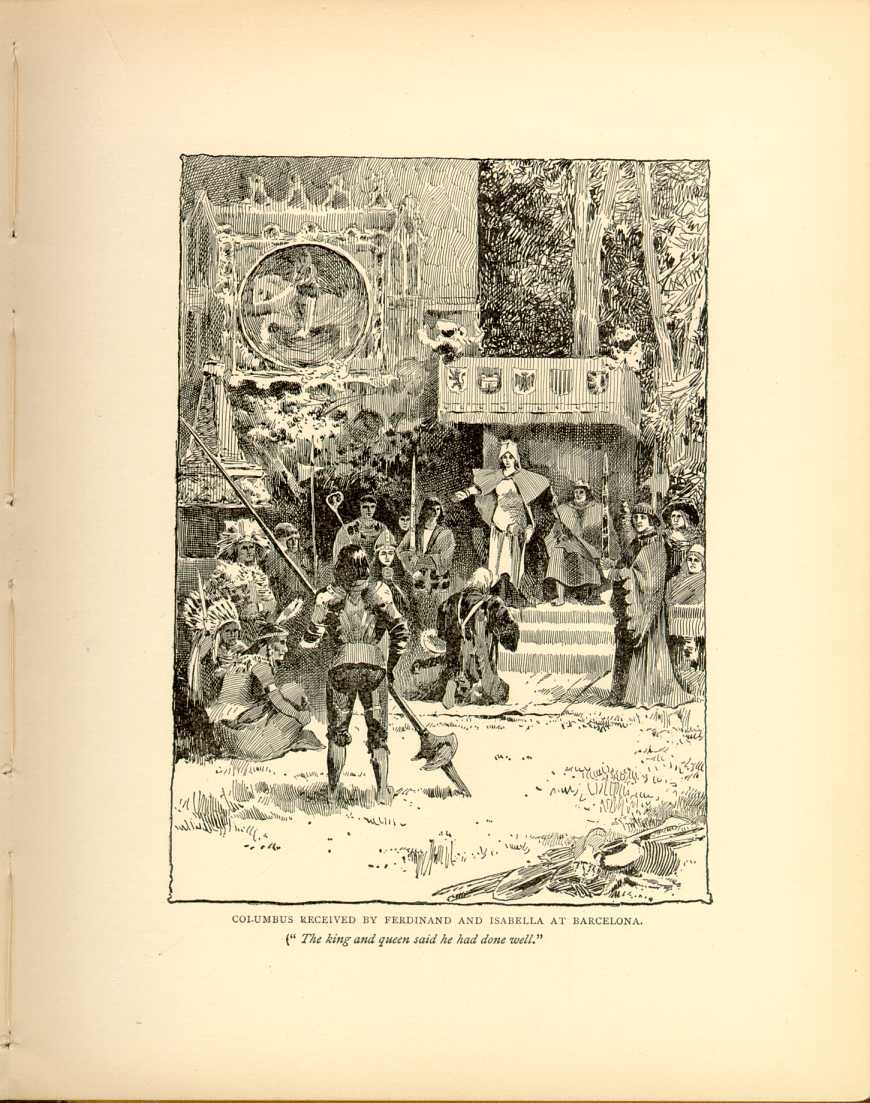
COLUMBUS RECEIVED BY FERDINAND AND ISABELLA AT BARCELONA.
("The king and queen said he had done well.")
[Description:
Drawing of Columbus standing before Ferdinand and Isabella and their court.
]
And in the midst of all this rejoicing what should sail into the
harbor of Palos but the Pinta, just a few hours late! And when
Captain Alonso Pinzon heard the sounds of rejoicing, and knew that his
plans to take away from Columbus all the glory of what had been done had
all gone wrong, he did not even go to see his old friend and ask his
pardon. He went away to his own house without seeing any one. And there
he found a stern letter from the king and queen of Spain scolding him
for trying to get the best of Columbus, and refusing to hear or see him.
The way things had turned out made Captain Alonso Pinzon feel so badly
that he fell sick; and in a few days he died.
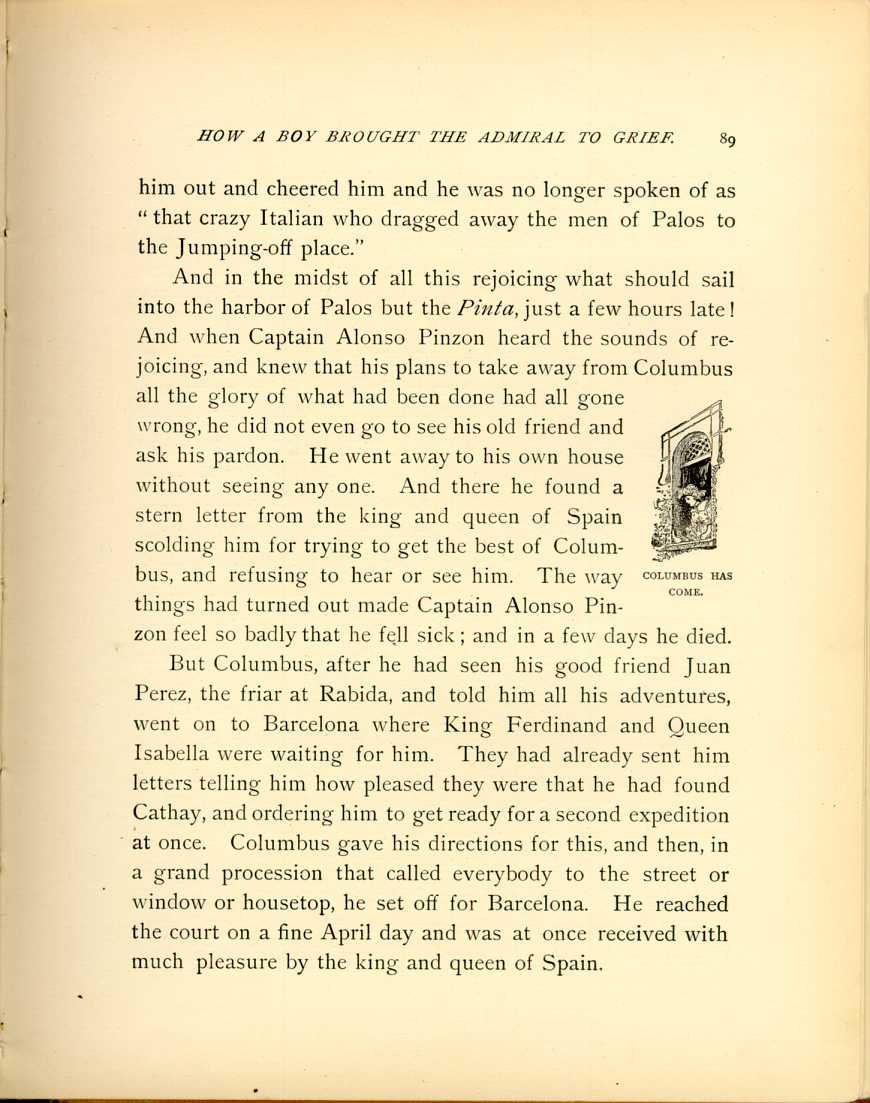
COLUMBUS HAS COME.
[Description:
Drawing of a woman looking out a window.
]
But Columbus, after he had seen his good friend Juan Perez, the friar at Rabida, and told him all his adventures, went on to Barcelona where King Ferdinand and Queen Isabella were waiting for him. They had already sent him letters telling him how pleased they were that he had found Cathay, and ordering him to get ready for a second expedition at once. Columbus gave his directions for this, and then, in a grand procession that called everybody to the street or window or housetop, he set off for Barcelona. He reached the court on a fine April day and was at once received with much pleasure by the king and queen of Spain.
Columbus told them where he had been and what he had seen; he showed them the gold and the pearls and the birds and curiosities he had brought to Spain as specimens, of what was to be found in Cathay; he showed them the ten painted and "fixed-up" Indians he had stolen and brought back with him.
And the king and queen of Spain said he had done well. They had
him sit beside them while he told his story, and treated this poor
Italian wool-weaver as they would one of their great princes or mighty
lords. They told him he could put the royal arms alongside his own on
his shield or crest, and they bade him get together at once ships and
sailors for a second expedition to Cathay—ships and sailors enough,
they said, to get away up to the great cities of Cathay, where the
marble temples and the golden palaces must be. It was their wish, they
said, to gain the friendship of the great Emperor of Cathay, to trade
with him and get a good share of his gold and jewels and spices. For,
you see, no one as yet imagined that Columbus had discovered America.
They did not even know that there was such a continent. They thought he
had sailed to Asia and found the rich countries that Marco Polo had told
such big stories about.
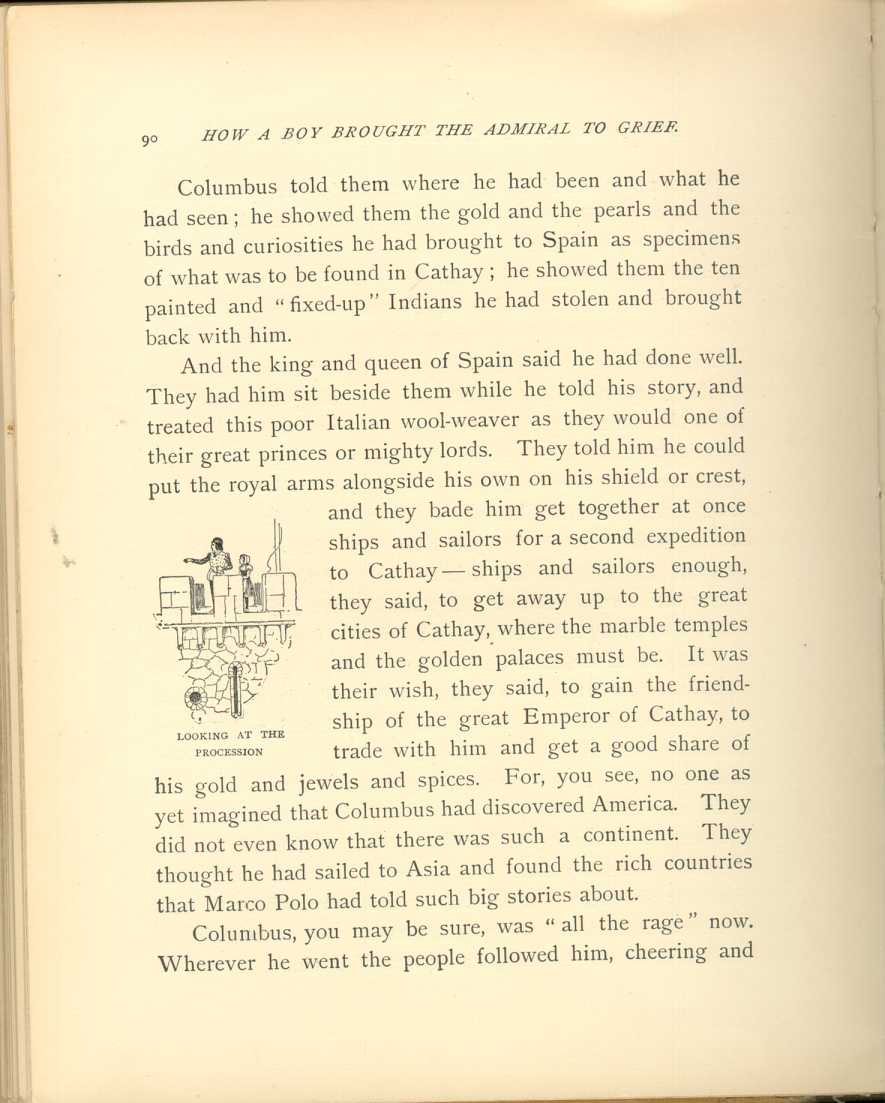
LOOKING AT THE PROCESSION.
[Description:
Drawing of two figures standing on a turret.
]
Columbus, you may be sure, was "all the rage" now. Wherever he went the people followed him, cheering and
He was as anxious as any one to get back to those beautiful
islands and hunt for gold and jewels. He set to work
at once, and on the twenty-fifth of September, 1493, with a
fleet of seventeen ships and a company of fifteen hundred
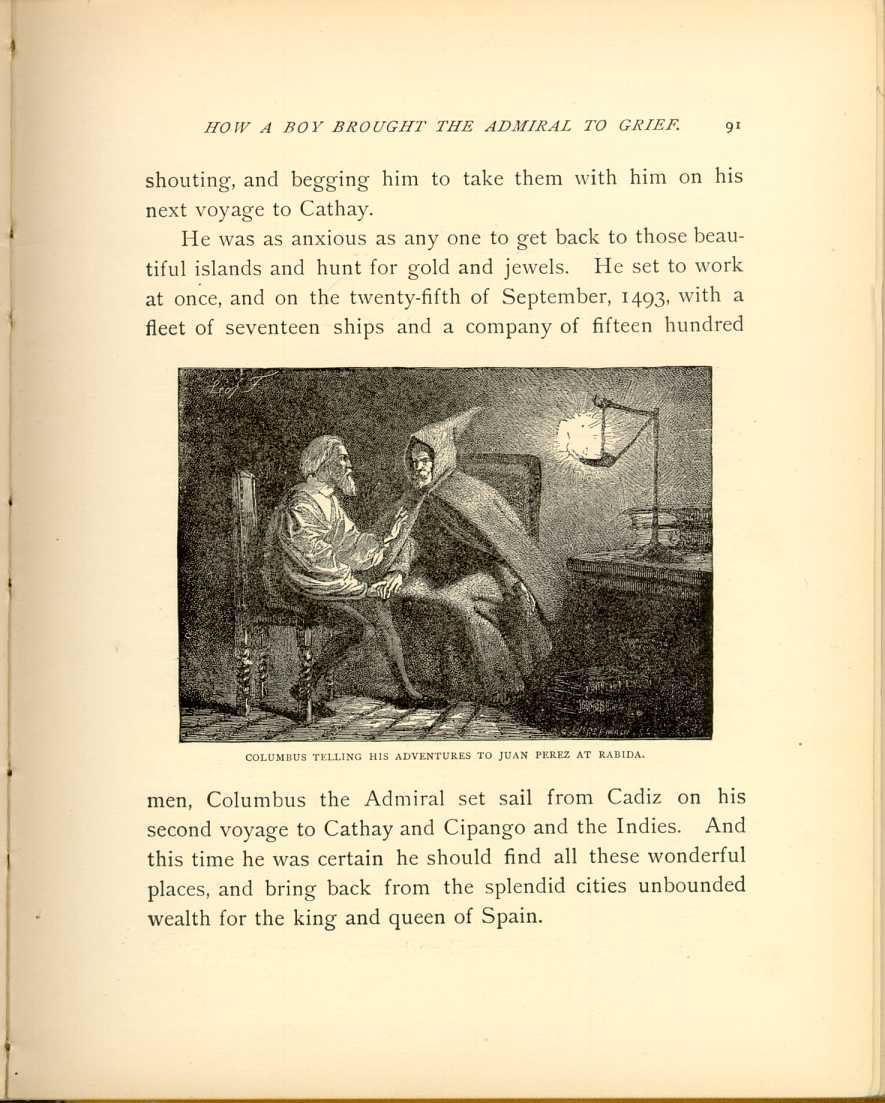
COLUMBUS TELLING HIS ADVENTURES TO JUAN PEREZ AT RABIDA.
[Description:
Drawing of Columbus sitting with Juan Perez in a dark room.
]
|
CHAPTER VII.
HOW A BOY BROUGHT THE ADMIRAL TO GRIEF.
The True Story of Christopher Columbus, Called the Great Admiral | ||